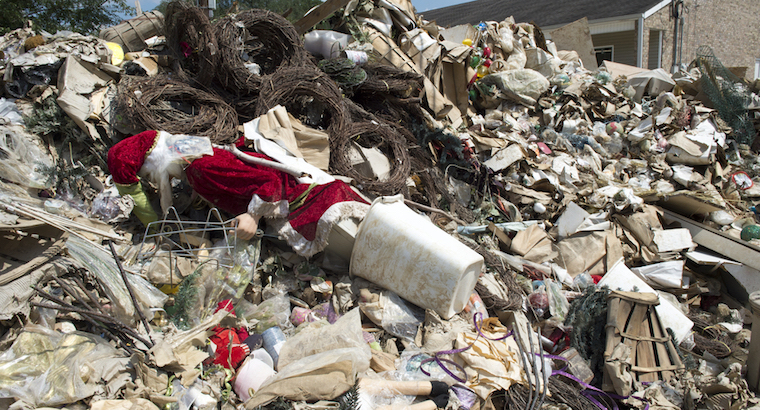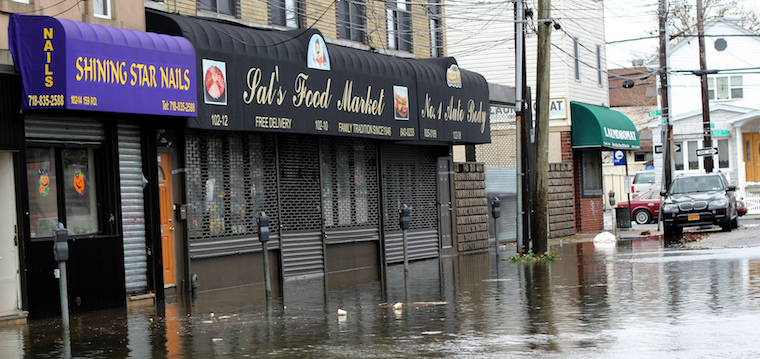September is National Preparedness Month, an awareness program from the U.S. Homeland Security. As we've seen many small businesses hit by personal disasters like a fire and others by mass disasters like hurricanes, we are serious when we urge you to prepare for something you hope you'll never encounter. The resources below, many developed through information supplied by the U.S. Small Business Administration, the Red Cross, the Federal Emergency Management Agency (FEMA) and other governmental and non-governmental organizations, can help you develop a plan to protect your employees, lessen the financial impact of disasters, and re-open your business quickly to support economic recovery in your community.
Photo | Small businesses in Howard Beach, Queens, New York, during aftermath of Hurricane Sandy taken on 10/30/2012 by Pamela Andrade via Flickr. (CC BY 2.0)
Also on SmallBusiness.com | Preparedness information on the SmallBusiness.com WIKI
Also on SmallBusiness.com | The SmallBusiness.com Guide to Emergency Preparedness
Thinkstock
7 Things to do Immediately to Prepare Your Business for a Disaster
1 Create | A preparedness program for your business (outlined in next section)
2 Identify | Critical business systems [PDF]
3 Prepare | An emergency communications plan [PDF]
4 Test | Your business systems
5 Enroll | In the Red Cross Ready Rating Program
6 Build | A disaster preparedness kit
7 Review | SmallBusiness.com's Guide to Emergency Preparedness
Thinkstock
Homeland Security's outline for a preparedness program for your business
Businesses can do much to prepare for the impact of the many hazards they face in today's world including natural hazards like floods, hurricanes, tornadoes, earthquakes and widespread serious illness. Human-caused hazards include accidents, acts of violence by people and acts of terrorism. Examples of technology-related hazards are the failure or malfunction of systems, equipment or software.
Ready.gov/Business has developed the following online tools that utilize an “all hazards approach” and follows the program elements within National Fire Protection Association 1600. (NFPA 1600 is an American National Standard and has been adopted by the U.S. Department of Homeland Security.)
The five steps in developing a preparedness program are Program Management, Planning, Implementation, Testing and Exercises, and Program Improvement. The links accompanying each step will take you to related information and tools at Ready.gov.
1 | Program Management
- Organize, develop and administer your preparedness program
- Identify regulations that establish minimum requirements for your program
Learn more about Program Management here.
2 | Planning
- Gather information about hazards and assess risks
- Conduct a business impact analysis (BIA)
- Examine ways to prevent hazards and reduce risks
Learn more about Planning here.
3 | Implementation
Write a preparedness plan addressing
- Resource management
- Emergency response
- Crisis communications
- Business continuity
- Information technology
- Employee assistance
- Incident management
- Training
Learn more about Implemenation here.
4 | Testing And Exercises
- Test and evaluate your plan
- Define different types of exercises
- Learn how to conduct exercises
- Use exercise results to evaluate the effectiveness of the plan
Find more information on Testing and Exercises here.
5 | Program Improvement
- Identify when the preparedness program needs to be reviewed
- Discover methods to evaluate the preparedness program
- Utilize the review to make necessary changes and plan improvements
Find more information on Program Improvement here.

Flood damaged holiday decorations and decor in a pile waiting for disposal outside of a craft shop in Denham Springs, La. (Photo by J.T. Blatty/FEMA)
Disaster Information in Specific Situations
Hurricanes
Winter Weather
- Winter weather preparedness checklist

- Tips on how to plan and prepare your business for winter weather
- Winter safety tips
Earthquakes
Tornadoes
Wildfires
Floods
Cyber Security
- Create a customized cyber security plan for your business
- Cyber security tips for your small business

- Take a cyber security workshop
Workplace Hazards & First Aid
- Get a free on-site safety consultation for your small business
- Get Occupational Safety and Health Act compliance assistance



No comments:
Post a Comment